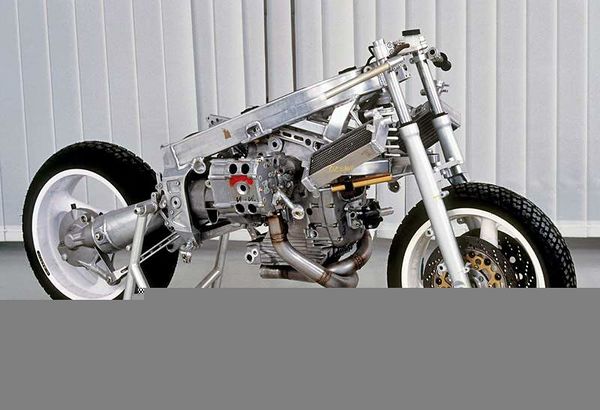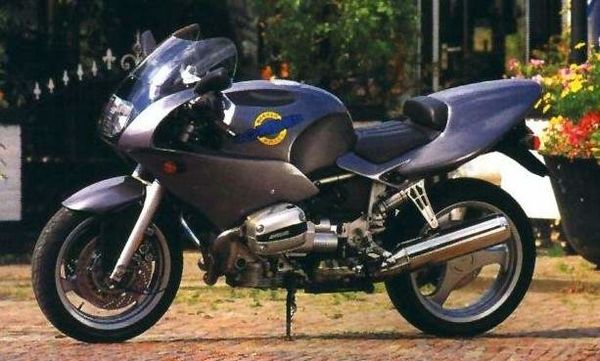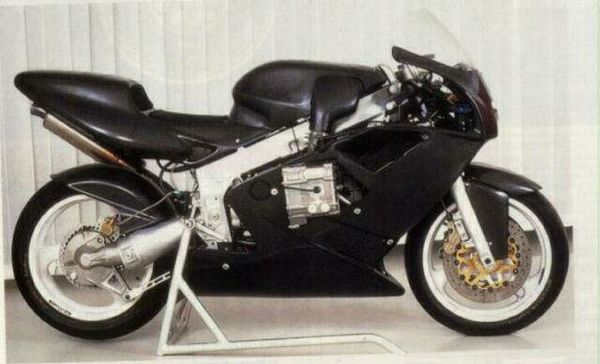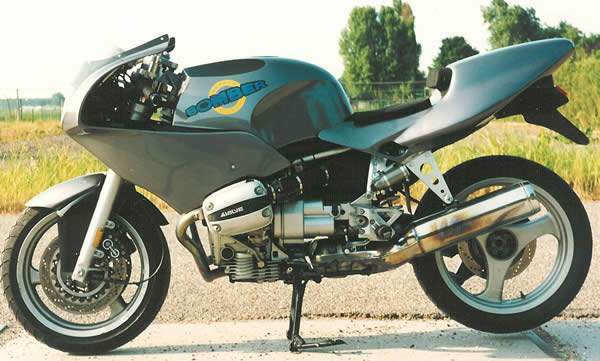Bakker BMW R1100 S - Bomber
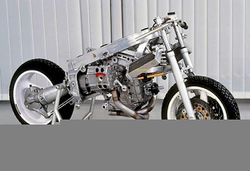 |
|
| Bakker BMW R1100 S - Bomber | |
| Manufacturer | |
|---|---|
| Production | 2000 |
| Engine | Four stroke, two cylinder horizontally opposed Boxer, 4 valves per cylinder. |
| Compression ratio | 10.7:1 |
| Ignition | Bosch Electronic |
| Transmission | 6 Speed |
| Frame | Three section composite frame consisting of front & rear section, load bearing engine |
| Suspension | Front: WP suspension, Motorrad Telelever, stanchion diameter 35mm, central strut, rebound damping adjustable. 110mm wheel travel Rear: WP suspension, Paralever, central strut, spring preload adjustable to continuously variable levels by mean of a hydraulic handwheel, rebound adjustable damping. 130mm wheel travel |
| Brakes | Front: 2 x 320 mm discs 4-piston calipers, Brembo Rear: Single 276 mm disc 2-piston caliper, Brembo |
| Front Tire | 120/70 ZR17 |
| Rear Tire | 160/60 ZR18 |
| Wheelbase | 1453 mm / 57.2 in |
| Seat Height | 800 mm / 31.5 in |
| Weight | 215 kg / 459 lbs (dry), |
| Fuel Capacity | 22 Liters / 5.8 US gal |
| Manuals | Service Manual |
Engine[edit | edit source]
The engine featured a 10.7:1 compression ratio.
Chassis[edit | edit source]
It came with a 120/70 ZR17 front tire and a 160/60 ZR18 rear tire. Stopping was achieved via 2 x 320 mm discs 4-piston calipers, Brembo in the front and a Single 276 mm disc 2-piston caliper, Brembo in the rear. The front suspension was a WP suspension, Motorrad Telelever, stanchion diameter 35mm, central strut, rebound damping adjustable. 110mm wheel travel while the rear was equipped with a WP suspension, Paralever, central strut, spring preload adjustable to continuously variable levels by mean of a hydraulic handwheel, rebound adjustable damping. 130mm wheel travel. The BMW R1100 S - Bomber was fitted with a 22 Liters / 5.8 US gal fuel tank. The bike weighed just 215 kg / 459 lbs. The wheelbase was 1453 mm / 57.2 in long.
Photos[edit | edit source]
Overview[edit | edit source]
Bakker BMW R 1100S - Bomber
The sound is instantly familiar, a
gentle scritch above the engine's exhaust note as the bike cranks through a
tight right-hand bend and my knee-scraper brushes the road. Nothing unusual
about that, in these days of sharp-handling bikes and fat, sticky tires.
Except that the machine I'm riding is a BMW the first boxer that I've ever
cornered fast enough to get anything other than a centrestand, cylinder head
or the toe of a boot touching the ground.
This is no normal BMW, mind. The aggressively styled single-seater, powered by the air-oil cooled motor from the R1100RS sports-tourer, is the work of Dutch chassis engineer Nico Bakker, designer of many classy specials and racebikes in a career stretching back 20 years.
Despite its typically restrained grey paint the Bomber, with its nose-down, seat-up profile, is an unmistakably sporty motorbike. Styled by Martin Longmore, who also shaped BMW's F650 single, it looks lean and purposeful from its carbon-fibre front mudguard all the way to a single-seat unit made from the same lightweight material. (This bike's fairing is fibreglass, but future versions will use carbon here too.)
The fairing is cut
short enough to reveal the distinctive angled four-valve heads
of the high-cam R1100RS engine, whose exhaust downpipes curl
down and back towards the big round-section silencer on the left
of the bike. At the other side is the boxer lump's hefty
shaft-drive housing and single-sided Paralever swing-arm,
holding an 18-inch rear wheel which, like the 17-inch front, is
a genuine BMW item.
This bike's powerplant
is unmodified from its airbox to its rather tarnished exhaust
system. But although BMW's Telelever front suspension system is
also retained, most of the chassis is far from standard. The
rear subframe is
made of 22 mm diameter aluminum tubes, instead of the original
steel, and lifts the rear of the bike slightly while retaining
roughly the original seat-to-pegs relationship.
The alloy front frame member is also altered. In conjunction with a slightly shorter than standard WP shock unit, plus a mod to the ball-joint at the top of the upper shock mounting bracket, the result is to lower the Bomber's front end relative to the R1100RS. Steering geometry is adjustable, the rake through three degrees and the trail using a choice of two locating plates. The figures are sportier than the RS's equivalents, though Bakker won't reveal exact dimensions.
The other major chassis change is to the Telelever set-up's main horizontal arm, which Bakker has shortened slightly and relocated to add a little extra dive under braking and put more weight on the front wheel. The front brake system, with its four-piston Brembo calipers and ABS, uses original components, but Bakker says that the suspension geometry changes make a difference to the way the anti-lock system operates. (The rear disc is smaller, as it is less useful on a single-seat sportster.)
The Bomber certainly felt very different to any conventional BMW as I sat astride the rather tall seat and reached forward to clip-ons mounted 20mm below the Bakker-made aluminum top steering plate. The shock's remote reservoir was clamped inside the fairing on the right, joined to the vertical damper unit positioned in front of the big alloy fuel tank. Clocks and switches were standard BMW, but the low screen added to the sporty feel.Other sensations were more familiar, such as the bike's sideways lurch from the flat-twin motor's longitudinal crankshaft, and the clunk from the ABS system as I pulled away. The BMW's Motronic fuel injection gave a typically crisp feel at low revs; the five-speed gearbox was just as slow-shifting as ever. I headed off into a typical Dutch downpour glad that the fairing, although insubstantial by BMW standards, provided a reasonable amount of protection from the elements.
That was equally true later, after the rain had stopped and the roads had dried out, when the Bakker bike was comfortable cruising along open Dutch main roads at an effortless 100 to 110mph. At that speed the screen kept the wind off my chest, there was very little vibration through the solidly mounted handlebars (1100RS bars are rubber-mounted), and a twist of throttle sent the Bomber surging obediently if rather gently towards an indicated 130mph.
Acceleration at lower speeds was hardly dramatic by super-sports standards, though with a peak output of 90bhp pushing a bike that weighs 215kg dry (20kg less than the standard R1100RS), the Bomber was pretty lively. Midrange response was strong, and in the lower gears the motor pulled hard to the redline at 7300rpm, though the vibration that increased noticeably above seven grand discouraged such thrashing.
High-rev performance could fairly easily be uprated with some mild engine work. Bakker is hoping to put together a tuning package, in conjunction with his German distributor, that would include fuel-injection, exhaust and possibly internal engine changes. There's also scope to uprate handling performance by swapping the standard wheels and front brake calipers for lighter racing parts.
That would further add to the agility of a bike which, although sporty by BMW standards, retained many of the donor R1100RS model's handling characteristics including the need for a fair amount of handlebar pressure to get it to change direction in a hurry. Anyone who's ridden a standard RS could imagine how Bakker's bike felt: basically like a firmer, slightly quicker-steering version of the original Telelever model.
Despite the extra brake dive that Bakker has engineered in, the bikes nose still dipped only very slightly when the anchors were used hard. Partly for that reason, the Bomber needed rather more effort than I'd expected to tip it into a bend. Once cranked over the bike tracked very accurately, though it had a slight tendency to stand up under braking. BMW's Paralever system did its normal good job of reducing the drive shaft's effect on handling, though the big twin still felt much more like a Guzzi Daytona than a Ducati 916.
Suspension at both ends was slightly firmer than standard RS, and the front shock's travel, at 90mm, was 25 per cent down on the original. Most of the time that felt just about right, giving the bike taut feel at both ends. If anything the front was a fraction firm, working best with the compression damping wound right back. Bakker is planning to revalve the shock slightly, so that this bike's minimum setting will become the midway mark on production versions. That didn't stop the front end tracking smoothly in corners, even when conventional forks might have used most of their travel dealing with braking and bumps. Despite its wheelbase being 20 mm shorter than the R1100RS's (at 1453mm) the Bomber still felt quite long and tall for a sports bike, and I took a bit of time to get used to throwing it into tight bends with the necessary confidence. But the harder I pushed it, the better the Bakker machine felt.
Steepening the steering geometry from this bike's midpoint settings could have quickened up the steering, though Bakker admitted that there would be a trade-off in stability, particularly under braking. This bike's tires both had rather worn-flat profiles, which didn't help. As it was, a big handful of front brake was enough to get the Bomber's rear wheel waggling in the air as the bike stopped very hard indeed.
Modifying the front suspension arm had certainly made a difference to the way BMW's anti-lock system worked. The ABS was now much less inclined to cut in, which allowed seriously hard use of the front Brembos in conjunction with the generous grip of the ubiquitous Michelin Hi-Sport radial front tire. The rear Hi-Sport, a 160/60-section 18-incher, looked skinny by current supersport standards but gripped well on the road. No solid bits dragged, despite some pretty hard cornering, although how the boxer's sticking-out pots would fare given slick tires and a racetrack remains to be seen.
Some of the bikes Bakker plans to build will probably find their way into twins racing, but most will no doubt be sold for road use to BMW fans eager for the sporty boxer the factory has never made. There may be some direct involvement from Munich, too. BMW has asked Bakker to visit and demonstrate the bike, confirming that the Dutchman, who has worked on development projects for the factory in recent years, is held in high regard there.One of those projects was the racebike that Bakker developed in 1991 and 92, and which was ridden to several top-six places in German BoT races by Herbert Enzinger. That bike also featured Telelever-style front suspension, although its two-valve engine required a much more substantial frame than the Bomber's. At the time there were rumours that the factory was planning to build a roadgoing version, but that never happened.
Bakker says he hopes BMW will like the Bomber enough to want to put something very similar into production, although the German firm's long-standing wariness about getting involved in the super-sport sector of the market makes that a long shot. Much likelier is that Bakker will be allowed to buy engines and the other parts he needs to build bikes himself, as Bimota is doing for its soon-to-be-released F650-engined BB1.
That would remove Bakker's current need to acquire a donor bike, as he did for this first machine, and would make producing the Bomber simpler and cheaper. Current price for a complete bike like this one is f40,000 (about £15,000), or f26,000 (£9500) if you supply an R1100RS with the necessary parts. A frame kit costs ff16,000 (£6000), including all suspension and bodywork, but excluding engine, electrics, wheels and brakes. Bakker's hand-built bikes have never been cheap, but that price is not excessive for a stylish, well-made and rapid sportster that handles better than any BMW I've ridden before. Never mind the usual set of panniers for this boxer. The only accessory a Bakker Bomber pilot needs is a fresh pair of knee-scrapers.
| Make Model | Bakker BMW R 1100S- Bomber |
|---|---|
| Year | 2000 |
| Engine Type | Four stroke, two cylinder horizontally opposed Boxer, 4 valves per cylinder. |
| Displacement | 1085 cc / 66.2 cu in |
| Bore X Stroke | 99 x 70.5 mm |
| Compression | 10.7:1 |
| Induction | Bosch fuel injection |
| Ignition | Bosch Electronic |
| Starting | Electric |
| Max Power | 71.4 kW / 98 hp @ 7500 rpm |
| Max Torque | 97 Nm / 9.89 kgf-m / 71.53 lb-ft @ 5750 rpm |
| Transmission | 6 Speed |
| Final Drive | Shaft |
| Frame | Three section composite frame consisting of front & rear section, load bearing engine |
| Front Suspension | WP suspension, Motorrad Telelever, stanchion diameter 35mm, central strut, rebound damping adjustable. 110mm wheel travel |
| Front Wheel Travel | 110 mm / 4.3 in |
| Rear Suspension | WP suspension, Paralever, central strut, spring preload adjustable to continuously variable levels by mean of a hydraulic handwheel, rebound adjustable damping. 130mm wheel travel |
| Rear Wheel Travel | 130 mm / 5.1 in |
| Front Brakes | 2 x 320 mm discs 4-piston calipers, Brembo |
| Rear Brakes | Single 276 mm disc 2-piston caliper, Brembo |
| Wheels | Marvic, 5-spoke |
| Wheelbase | 1453 mm / 57.2 in |
| Front Tire | 120/70 ZR17 |
| Rear Tire | 160/60 ZR18 |
| Seat Height | 800 mm / 31.5 in |
| Dry Weight | 215 kg / 459 lbs |
| Fuel Capacity | 22 Liters / 5.8 US gal |
